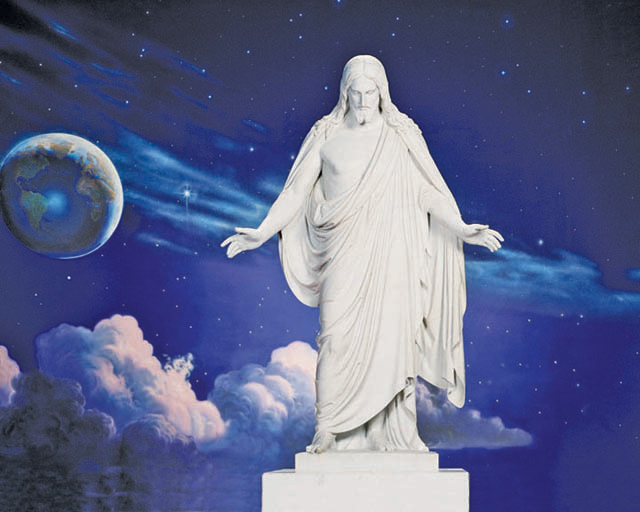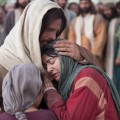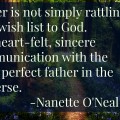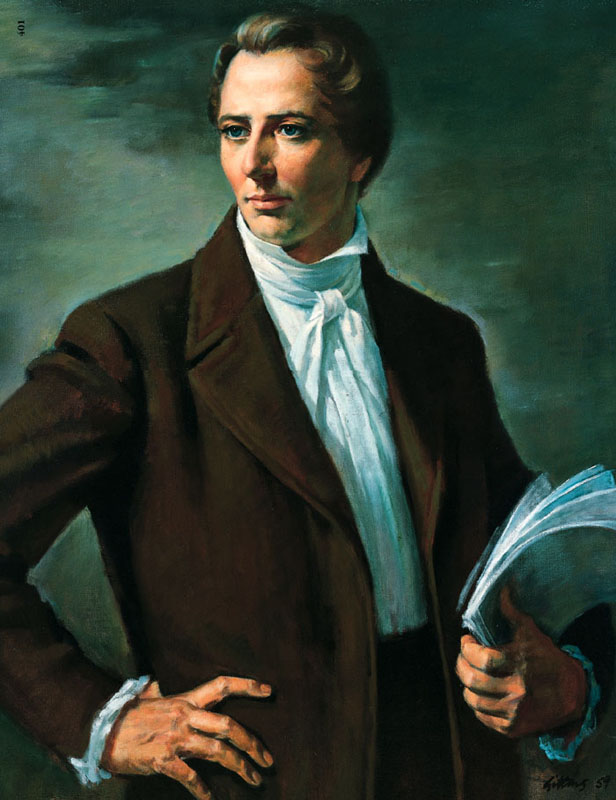How do you teach a child about the Atonement of Christ? That’s easy. How do you teach an adult? That’s a little more complicated, and it shouldn’t be.
I was asked to teach a lesson to a group of children, whose ages ranged from five to eleven, on the Atonement of Christ—a very difficult subject for anyone to wrap their brains around. My task was to teach the first half of a scripture known as the Third Article of Faith. It begins, “We believe that through the Atonement of Christ all mankind may be saved.” This is a deep concept that theologians and philosophers debate even today. But here I am—a simple Primary counselor—asked to help children understand something great minds can’t even agree on.
I thought, if I am to do this, then Heavenly Father must believe the Atonement of Jesus Christ is a concept that even the most innocent minds can grasp. Therefore, it can be done. The gauntlet was thrown down.
 I began the lesson by telling a story from the teacher’s manual in my own words. “Today, we’re going on an adventure. Imagine we’re all going star gazing. We take our jackets to keep warm and a blanket or two to lie on. As we leave, our parents say, “Wait! Can we come? We’ll bring snacks.” So we let them to join us, and we walk down the street. We see our Bishop and his counselors and their families, too. Each one asks to join us, and we say yes. Soon the whole congregation is following us. We find a great field, lay out our blankets and enjoy the night sky.
I began the lesson by telling a story from the teacher’s manual in my own words. “Today, we’re going on an adventure. Imagine we’re all going star gazing. We take our jackets to keep warm and a blanket or two to lie on. As we leave, our parents say, “Wait! Can we come? We’ll bring snacks.” So we let them to join us, and we walk down the street. We see our Bishop and his counselors and their families, too. Each one asks to join us, and we say yes. Soon the whole congregation is following us. We find a great field, lay out our blankets and enjoy the night sky.
“After a while, we decide to go home, and our class leads the way. Suddenly, we fall in a deep ditch, thirty feet straight down. Everyone is hurt—broken wrists, ankles, bumps and bruises. We call to our parents above for help. When they reach the edge, they fall in too. We all call to the Bishop and his counselors, but they fall in. Soon the entire congregation falls in, and we’re all in grave danger. We look around and notice the ditch is filled with people—friends, strangers, even people from around the world, and everyone is hurt. We soon realize no one is left to save us. What will we do?”
(By this time the little children were riveted to the story. The older children were trying to figure out ways to get out of the pit. But in order to keep to the lesson, I had to shoot down each of their ideas. In this story, there was no way they could get out by themselves. Back to the story…)
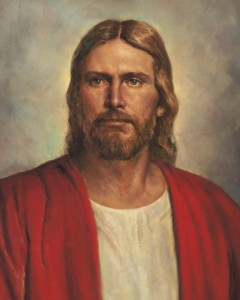 “When we are about to give up all hope, we see the silhouette of a man standing at the edge of the ditch. He knows the edge very well. He knows how to negotiate so he will not fall in. He calls to us by name and tells us not to fear. He lowers down a ladder and climbs down. Then he asks the first of us if we can make it up the ladder. The first child says, “Not with my broken ankle.” He says, don’t worry.” He grabs on to her and carries her up the ladder. He then comes down again and asks the next child, who also needs help. He carries him up the same way. He repeats this process—down the ladder, up the ladder, down again, up again—for every child. He asks if they need help, carries them if they do, or follows right behind them on the ladder if they think they can do the climbing on their own. But he makes the climb down and up again for each child, one at a time. Then he does the same for the parents, the bishop, his counselors, the congregation, your friends, the strangers, everyone. Tirelessly, he endures the struggle of the climb. No one is left in the ditch.
“When we are about to give up all hope, we see the silhouette of a man standing at the edge of the ditch. He knows the edge very well. He knows how to negotiate so he will not fall in. He calls to us by name and tells us not to fear. He lowers down a ladder and climbs down. Then he asks the first of us if we can make it up the ladder. The first child says, “Not with my broken ankle.” He says, don’t worry.” He grabs on to her and carries her up the ladder. He then comes down again and asks the next child, who also needs help. He carries him up the same way. He repeats this process—down the ladder, up the ladder, down again, up again—for every child. He asks if they need help, carries them if they do, or follows right behind them on the ladder if they think they can do the climbing on their own. But he makes the climb down and up again for each child, one at a time. Then he does the same for the parents, the bishop, his counselors, the congregation, your friends, the strangers, everyone. Tirelessly, he endures the struggle of the climb. No one is left in the ditch.
“Somewhere along the way up the ladder, our wounds are healed miraculously. When he finishes rescuing everyone, he pulls up his ladder, turns to us and says, “Now you can go home.” We thank him and we all make it safely home.”
I asked the children to tell what they learned from the story. After weeding out answers like, “Take a flashlight when you go star gazing,” from the older boys, we narrowed the meaning of the story down to this:
“We have seen that with a ladder and some help from one man alone, everyone was allowed to make it home.”
The children’s eyes lit up as they began to recognize the correlation between the story and the Atonement. If a child can understand the message of the Atonement of Jesus Christ, and receive comfort and joy in the process, why do adults complicate it? The scriptures are filled with numerous stories that caution God’s people against searching for the complex answers rather than following a more simple solution (Moses and the brass serpent, Naaman bathing in the waters of Jordan, Jacob talking about the Jews missing the mark). And yet we still make this basic mistake—we forget that a gospel message filled with love was not intended to be painful to decipher. Children know this—it is inherent in their being.
“Verily I say unto you, Whosoever shall not receive the kingdom of God as a little child shall in no wise enter therein,” (Luke 18:17.).
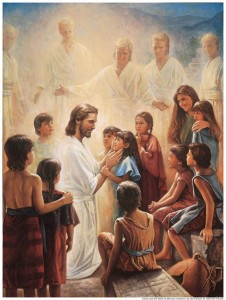 As I worked on this lesson prior to presenting it, I gave pause to the sentence that defined the essence of the story of the man with the ladder. “We have seen that with a ladder and some help from one man alone, everyone was allowed to make it home.” I compared it, word for word, to the Third Article of Faith and realized how clear this concept truly is—not only for a child to understand but in a way that might remind us all why we are worth saving.
As I worked on this lesson prior to presenting it, I gave pause to the sentence that defined the essence of the story of the man with the ladder. “We have seen that with a ladder and some help from one man alone, everyone was allowed to make it home.” I compared it, word for word, to the Third Article of Faith and realized how clear this concept truly is—not only for a child to understand but in a way that might remind us all why we are worth saving.
The Third Article of Faith in the LDS Church is a declaration and a two-way covenant. It declares boldly, “We believe that through the Atonement of Christ, all mankind may be saved…” there is a second part to this scripture, but since the lesson for the children was to focus only on the first half, this blog post will do the same. Perhaps a narrow focus will spark a new understanding of our worth in the Savior’s eyes.
In the story, everyone fell in the ditch except for one man. In life it is the same way. We all fall short of making it to our spiritual home without the help of one man. There is much confusion in the world today as to who that man is, and what the actual act is that provides salvation. We state it clearly. The man is Jesus Christ and the act is the Atonement—his suffering, death, and resurrection.
“Jesus said unto him, I am the way, the truth, and the life; no man cometh unto the Father, but by me.” (John 14:6)
There is no other way to salvation, no way back to the Father, no way home, except through Jesus Christ. Others may try to convince us there is more than one way, or that Christ is not the true way. We declare clearly through the Third Article of Faith that He alone is the way. Mohammed is not the way. Buddha is not the way. Your favorite athlete is not the way. Your favorite politician is not the way. None of these people provide salvation. None of these people overcame death, sin and suffering. None of these people can take away the blemishes of an impure life. Only Jesus Christ, through the Atonement, makes this possible.
“For as in Adam all die, even so in Christ shall all be made alive.” (1 Cor. 15:22)
 I want to discuss the word, may, a word that carries authority, majesty and power. I think it causes undue grief for many people who confuse its meaning. Some people read it with uncertainty rather than authority. In the dictionary, the word, may, has multiple meanings. The one I’d like to focus on is “to give permission”. When you are in a courtroom and the bailiff says, “All arise,” you stand out of respect for the judge. The judge then says, “You may be seated.” He uses the word, may, because he is expressing permission given by one in authority. The judge doesn’t mean, “Sit if you want to, or not.” He is giving you permission to sit by virtue of his authority as a judge. Thus, the word, may, is a word to be revered.
I want to discuss the word, may, a word that carries authority, majesty and power. I think it causes undue grief for many people who confuse its meaning. Some people read it with uncertainty rather than authority. In the dictionary, the word, may, has multiple meanings. The one I’d like to focus on is “to give permission”. When you are in a courtroom and the bailiff says, “All arise,” you stand out of respect for the judge. The judge then says, “You may be seated.” He uses the word, may, because he is expressing permission given by one in authority. The judge doesn’t mean, “Sit if you want to, or not.” He is giving you permission to sit by virtue of his authority as a judge. Thus, the word, may, is a word to be revered.
Let’s read the first half of the Third Article of Faith with this definition in mind. “We believe that through the Atonement of Christ, all mankind may be saved.” It states that Jesus Christ alone has the authority to save. He exercises his authority through the Atonement, the only possible act known to mankind that will provide salvation. Because of His covenant, and through His divinity, love, and mercy, we are allowed to partake of this salvation (may be saved). Our blood has been washed clean through Him. The Third Article of Faith clearly distinguishes the Atonement as the only authoritative saving act and as Jesus Christ as the only one with authority to provide it. It is as if Christ is standing as the judge in the courtroom saying, “You may be saved,” meaning, “You have my permission to be saved.” And He gives this permission to everyone (all mankind). This was the covenant He made with each of us before we were born.
“Yea, they may forget, yet I will not forget thee, O house of Israel. Behold, I have graven thee upon the palms of my hands.” (1Nephi 21:15-16).
 Christ is bound by his covenant, the one he made before we were born. When Heavenly Father said, “Whom shall I send?” Christ volunteered. He covenanted before the world began that He would be our Savior, that He would complete the act of the Atonement perfectly so that we could make it home. He did this because he loves us—we are worth loving. We are worth saving. To think otherwise is to second-guess the Savior’s Atonement—to decide we know better than He. To think, perhaps he didn’t suffer enough because we’re not worth it.
Christ is bound by his covenant, the one he made before we were born. When Heavenly Father said, “Whom shall I send?” Christ volunteered. He covenanted before the world began that He would be our Savior, that He would complete the act of the Atonement perfectly so that we could make it home. He did this because he loves us—we are worth loving. We are worth saving. To think otherwise is to second-guess the Savior’s Atonement—to decide we know better than He. To think, perhaps he didn’t suffer enough because we’re not worth it.
We must not fall into the trap of thinking that Christ’s part in salvation is conditional—that He might rescind his half of the agreement. This contradicts His very nature and discredits His role in the covenant He made with us. We must not think He would simply change His mind like a fickle friend if we’re not living up to a set of standards that only He could meet. This is a dangerous mindset that can make a person feel they will never be good enough, and therefore not worthy of salvation. It is Christ’s love for us that makes us worthy. It is his Atonement that paid for our freedom. When welcoming us into heaven, He, alone, will say—with authority and with permission— “You may enter.”
It was amazing to see the “light bulbs” click in the children’s faces as they began to understand the meaning of the story. Christ’s Atonement was akin to the man with the ladder who helped each of them, one by one, out of the ditch. Somewhere along the way, we, as adults, forget the ladder is extended to us as well, each week, when we can partake of the sacrament and become clean again. If a child can understand the beautifully simplistic nature of Christ’s mercy, we can too.
The Third Article of Faith outlines a covenant—a two way promise. The first part is Christ’s promise.
He is bound by his half. He atoned for us, overcoming death, sin, sorrow, and pain. He will never go back on his covenant. Take a week to ponder the enormity of this love—the love he has for you. Ponder without doubt, without reservation. Believe it, because it is true.
In the next few weeks we’ll explore the story of the man with the ladder more deeply. We’ll see what it meant for him to make the climb, what it took for us to grab hold, how this changes us forever, and how this connects us to Christ through our part—the second half of the covenant.
About Nanette ONeal
Nanette O'Neal loves the gospel and is very happy to share her testimony on LDS Blogs. She is a convert to the church and still feels the spirit burn strong within her heart. She graduated from Mason Gross School of the Arts with a degree in music education and has taught children and adults in the private and public sphere for over twenty years. Nanette continues to study the gospel and the art of writing. She writes weekly inspirational articles on her blog and is currently working on an LDS fantasy novel series, A Doorway Back to Forever. You can find her at NanetteONeal.blogspot.com. Nanette has a wonderful husband, talented son, and three beautiful dogs.

